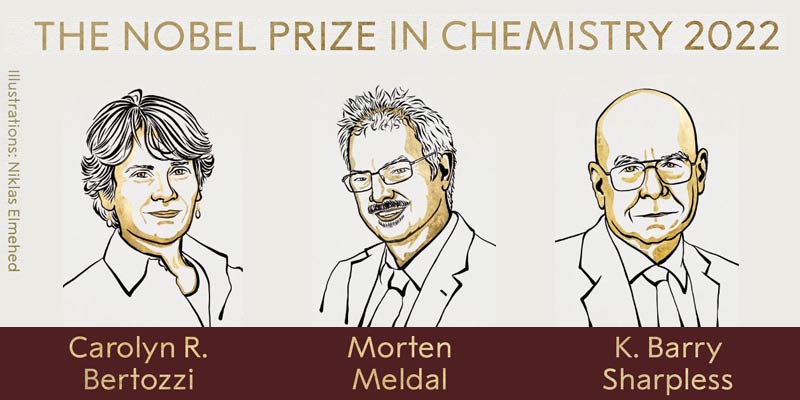- World
- Oct 05
3 scientists win Nobel for development of ‘click chemistry’
• Scientists Carolyn Bertozzi, Morten Meldal and Barry Sharpless won the 2022 Nobel Prize in Chemistry for discovering reactions that let molecular building blocks snap together to efficiently create new desired compounds.
• The technologies known as click chemistry and bioorthogonal chemistry are now used globally to explore cells and track biological processes. Using bioorthogonal reactions, researchers have improved the targeting of cancer pharmaceuticals, which are now being tested in clinical trials.
• Sharpless joins an elite band of scientists who have won two Nobel Prizes. Barry Sharpless won Nobel Prize in Chemistry in 2001 for his work on chirally catalysed oxidation reactions. Other individuals who won twice are John Bardeen (Physics), Marie Curie (Physics and Chemistry), Linus Pauling (Chemistry and Peace) and Frederick Sanger (Chemistry).
• The 2021 chemistry award was won by German Benjamin List and Scottish-born David MacMillan for their work in creating new tools to build molecules, aiding in the development of new drugs as well as in areas such as plastics.
What is click chemistry?
• Ever since the birth of modern chemistry in the 18th century, many chemists have used nature as their role model. Life itself is the ultimate proof of nature’s supreme ability to create chemical complexity. The magnificent molecular structures found in plants, microorganisms and animals have spurred researchers to try to construct the same molecules artificially. Imitating natural molecules has often also been an important part in the development of pharmaceuticals, because many of them have been inspired by natural substances.
• Centuries of accumulated knowledge in chemistry has proved its worth. In pharmaceutical research, this has often involved artificially recreating natural molecules with medicinal properties. However, one challenging problem is that complex molecules must be built in many steps, with each step creating unwanted by-products – sometimes more and sometimes fewer.
• This has led to many admirable molecular constructions, but these are generally time consuming and very expensive to produce.
• Around the year 2000, Barry Sharpless coined the concept of click chemistry, which is a form of simple and reliable chemistry, where reactions occur quickly and unwanted by-products are avoided.
• Shortly afterwards, Morten Meldal and Barry Sharpless – independently of each other – presented what is now the crown jewel of click chemistry: the copper catalysed azide-alkyne cycloaddition. This is an elegant and efficient chemical reaction that is now in widespread use. Among many other uses, it is utilised in the development of pharmaceuticals, for mapping DNA and creating materials that are more fit for purpose.
• Carolyn Bertozzi took click chemistry to a new level. To map important but elusive biomolecules on the surface of cells – glycans – she developed click reactions that work inside living organisms. Her bioorthogonal reactions take place without disrupting the normal chemistry of the cell.
• Glycans are complex carbohydrates that are built from various types of sugar and often sit on the surface of proteins and cells. They play an important role in many biological processes, such as when viruses infect cells or when the immune system is activated.
The click reaction that changed chemistry
• Click reactions are now used globally to explore cells and track biological processes. Using bioorthogonal reactions, researchers have improved the targeting of cancer pharmaceuticals, which are now being tested in clinical trials.
• Click chemistry and bioorthogonal reactions have taken chemistry into the era of functionalism. This is bringing the greatest benefit to humankind.
• Many researchers have also started to develop clickable antibodies that target a range of tumours. Once the antibodies attach to the tumour, a second molecule that clicks to the antibody is injected. For example, this could be a radioisotope that can be used to track tumours using a PET scanner or that can aim a lethal dose of radiation at the cancer cells.
Manorama Yearbook app is now available on Google Play Store and iOS App Store


